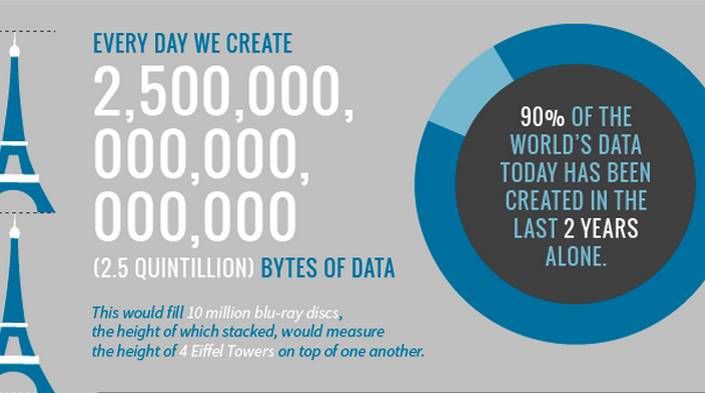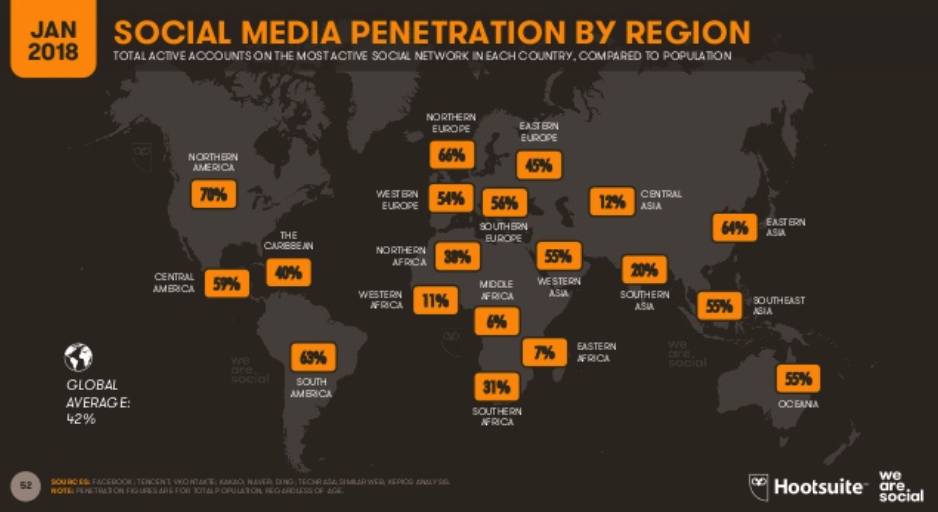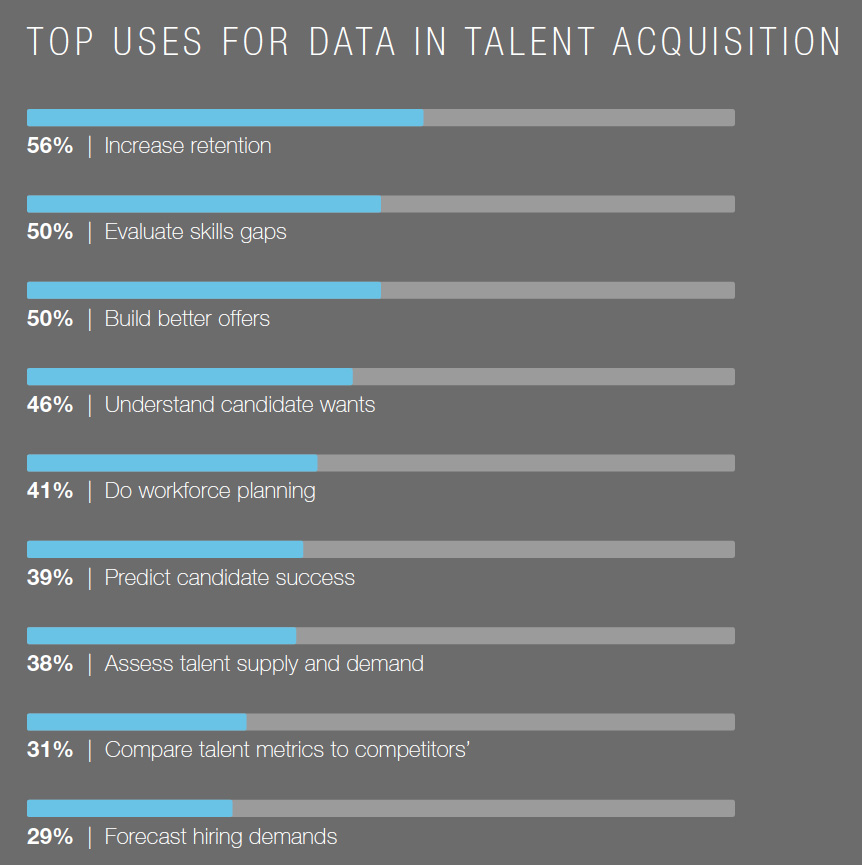Recruitment is changing: do you remember when you used to draw up the job ad, post it, read the resumes that came in, interview a few select candidates, and then offer one of them the job?
With the vast number of vacancies and job hunters now, this just isn’t humanly possible.
So the industry looked for ways to make recruitment easier, to let technology shortlist the good candidates as HR didn’t have the time.
While applicant tracking software has been (and continues to be) hugely useful, it isn’t efficient or comprehensive enough to help recruiters uncover the most qualified candidates from the massive pool of talents, even if those candidates’ profiles exist in the recruiters’ databases.
So it’s time to evolve again: to incorporate big data into recruitment.
Big data is the topic du jour in every industry: financial services, telecommunications, healthcare and more. But what exactly is it?
Like what you see?
Don’t miss out. Subscribe to our quarterly digest to get the latest TA and TM resources delivered right to your inbox.
What is big data?
Big data is the vast volume of structured or unstructured data that is readily available at our collective fingertips. These large data sets are analyzed to reveal previously unknown patterns and provide insights into businesses, human behavior, and more. Big data analysis is used for everything from financial services, to gauging someone’s productivity, to even monitoring the weather.
Incredible amounts of data are created every day. It would be a waste not to use them to gain insights. (Image source)
Companies all across the spectrum and from every conceivable industry look up to big data for solutions on how to leverage the available data in meaningful ways for them.
For example, sales, marketing, and operations are renowned for relying on big data analytics in making business decisions to uncover hidden patterns, unknown correlations, market trends, customer preferences, and other useful business tidbits. Gaining these insights then helps them make decisions backed by data.
How is big data used in recruiting?
Big data, or people analytics, as it is known when applied to recruiting, is the monumental volume of data that recruiters have access to and analyze, to help them with their quest to find the ideal employee.
Big data recruiting is more than merely screening resumes for keywords or social media data mining. It is a way to create a 360-degree picture of a candidate before they have even stepped foot in the building for their first interview.
Our entire lives now are pretty much played out online: all of our personal data is ready and available (GDPR permitting) for all and sundry to access, and it is a goldmine of information for recruiters to dig down into.
In this day and age, a resume is just too one-dimensional. You want the complete picture of a candidate, warts and all, in order to assess them accordingly, and that is just what big data affords you.
Sure, use the keywords of applicant tracking software to guide your search, but don’t let them define it. Look beyond the keyword and into semantic analytics: extract all the information from a candidate and then analyze the data.
Because that is the point of big data – to analyze, understand and interpret it in order to give you a full a picture as possible about a candidate.
In order to accurately interpret data, you need to start with asking the right questions which you’re looking to answer. (Image source)
What data can recruiters collect?
It can be expensive and time-consuming trying to find those employees who will not only perform well but who will stay too.
Why not just continue to filter candidates using applicant tracking software? Because it is too restrictive and inflexible in its elimination approach. So much information is available about the potential candidates, from sources such as:
- social media profiles like LinkedIn and G+
- resume databases
- performance reviews
- business cards
- political associations
- online behavior, such as shopping and reading preferences
Data can be collected from many sources to provide information about a candidate’s prior experience, achievements, skills, warning signs, etc.
Some of the most common data that recruiters collect are:
1. Data from resumes. Resumes remain vital in the recruitment process because they are the stepping stone from which big data can be used to verify the information they contain.
You could even uncover some gems that would normally be filtered out, people who might not necessarily have the paper qualifications that you are looking for but have the skills and expertise to do the job and outstrip anyone with an actual qualification at 100 yards.
2. Data from pre-employment assessments. Pre-employment tests are as old as hiring itself. Usually, applicants are invited to take a skills test, a personality test, or both.
The skills tests are used to corroborate the skills listed on the resume, but also can be used to test those not listed, such as soft skills or situational judgement. The personality tests are also used to assess a candidate’s fit with the firm’s culture. Based on the scores, a recruiter can see whether a candidate matches the requirements for the vacancy.
3. Data from social media profiles. Special emphasis can be placed on those candidates who demonstrate their expertise on social media channels like Facebook, Twitter, LinkedIn, even Quora, by sharing advice, thought leadership, and interesting industry insights.
It isn’t a one-way street either. You can use the data collected to initiate conversations with prospects, to get to know potential candidates before you invite them in for an official interview.
70% of people in North America use social media, so there is a big chance you will find your candidates on them too. (Image source)
Besides all this, data can also be collected and analyzed to keep up with, and ahead of, job market trends.
Why is big data recruiting helpful?
Nowadays, recruiters can collect data from all these diverse sources to get a sense of the personality and skills of the candidates. In other words, they gather a vast amount of information.
But what to do with it? That’s where big data steps in.
Big data is the analytical approach to accumulating and interpreting all of the data sets for trends and revelations and can be helpful in predicting a candidate’s success in a given role.
Use of big data is looking promising in the recruitment industry and it can become a standard in the future, as long as those employing it can make sense of it.
Once you know what you’re looking for, you get an almost complete picture of a candidate, both professionally and personally – it is far more revealing than a one-page cover letter and an accompanying resume. Being able to do the job is only half the battle, aligning with company culture, ethos and core values is the rest.
Big data in recruitment:
- Removes bias in hiring because the hire won’t be based on subjective factors.
- Helps manage large volumes of applications in a short time.
- Streamlines the recruitment process, making it more efficient, thus reducing the cost per hire and the average time needed to fill open positions.
- Has the ability to predict talent needs by analyzing trends in the voluminous data.
- Has the ability to predict the success of applicants by combining data mining with predictive analytics.
- By using statistical methods and techniques recruiters can forecast the probability of an occurrence using historical data. For example, they can make predictions about a candidate’s likely tenure with the firm should they be hired.
- Social networks are an invaluable source because they reveal whether a candidate might be a good fit for the culture of the firm. For instance, a social network might show that a candidate enjoys pastimes that might impair their productivity, such as excessive drinking or high-risk hobbies – red flags to any discerning recruiter.
There is no shortage of applicant tracking systems and analytical programmes that can help a recruiter in their eternal quest for the right candidate. However, gathering and collating the information is only part of the process.
The recruiter still has to also be able to interpret the results, to understand what they’re indicating and the importance of each data point.
Which is why today’s recruiters have to be able to not only understand the concept of big data but to understand big data itself.
Big data shouldn’t usurp other paths to recruitment and other recruiting activities. While algorithms are learning what recruiters are looking for, you shouldn’t negate the need for the human element in recruitment just yet. Perception and the judgement of the recruiter remain important factors in determining a candidate’s potential, both for the job and for fitting in with the company culture.
If you want to be successful as a recruiter, then you have to know how to weight the data points in order to provide the best possible fit for a position.
Big data should be used to augment current recruiting practices, not replace it entirely.
Data has various uses in talent acquisition, including understanding candidate wants and predicting candidate success. (Image source)
What risks are there in using big data?
Big data can be so useful for recruiting, but beware it comes with its own inherent risks – everything from violating privacy laws to misconstruing the returned results. Don’t forget to address these issues when implementing big data recruiting at your company.
1. GDPR.
If you haven’t been swept up in the tidal wave of GDPR emails, where have you been? GDPR is all about how companies store and manage personal data.
If you have been collecting data, it is no longer enough to give people an opt-out option. If you’re holding their data, the new provisions require people to give explicit consent around the use of their data and give individuals the right to access and take greater control over the data you hold on them.
Data that is collected without the candidate’s knowledge or consent and algorithms that use the data could lead to potential bias and profiling, not to mention legal problems.
Ensure that your organization is GDPR-compliant in collecting data about job applicants.
2. Ethics.
Ethical issues surround data-driven hiring in the grey area: is there a privacy line being crossed if you are using someone’s Facebook profile to make a hiring decision?
Can you really use someone’s online personality and presence, their non-professional data as an excuse not to hire them? Probably not, but it can guide your judgement.
3. Potential bias.
Discrimination claims due to violations of equal opportunity law could arise if you are solely using big data to find your next great hire. Human bias might be projected onto the recruitment algorithms.
That’s why recruiters must ensure that that their hiring algorithms are not discriminating against anyone, especially minority employees, and that their algorithm takes a country’s diversity laws into account.
4. Misconstruing data.
Untrained recruiters might not be able to interpret the results correctly or rely on them too much. There also needs to be an agreement in place beforehand what metrics you are focusing on. Reverse-engineer the process: start with what you want to achieve and work backward. If make a wrong hire it can end up costing you both time and money.
Nine times out of ten, these risks arise due to over-reliance on algorithm-driven recruiting, so be warned: use it in partnership with your existing recruitment methods, let is supplant your efforts, not supersede them.
To sum it up
Big data recruiting can help you recognize patterns and identify great candidates faster and in a more cost-efficient way than you currently have.
However, you can’t solely rely on the information it provides to give you all the answers you’re looking for, it can only guide you. Recruitment experts still need to correctly interpret the results to make the best decision.
The full potential of big data recruiting can be unlocked with people understanding its principles.
Despite the risks, algorithm-driven approaches to recruiting are here to stay and the advancement of big data has expedited the rate of development in machine learning. (Machine learning is the design and study of learning algorithms that, essentially, help a computer process and understand data better).
Machine learning will be the next evolution of recruitment as technology continues to evolve, creating more accurate algorithm-based recruitment tools.
But for now, while big data drives hiring decision making, it shouldn’t be done without human engagement.
Recruit smarter, not harder.






